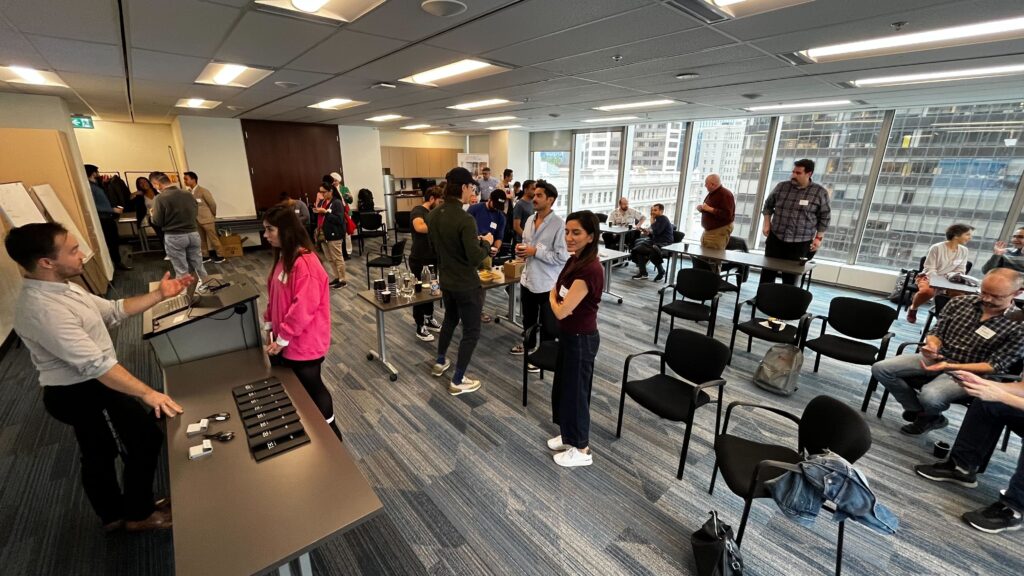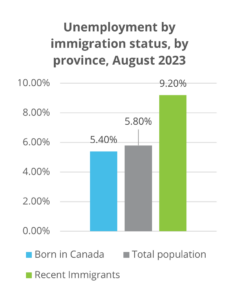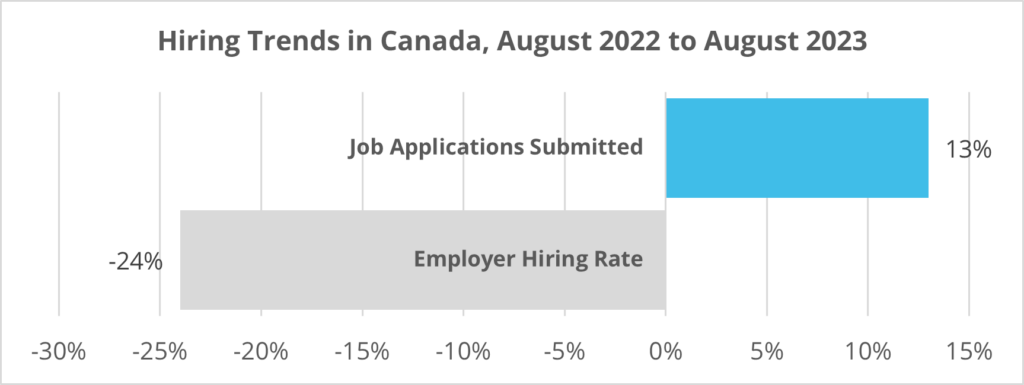
By Ryan Carter, Project Lead at the Immigrant Employment Council of BC
It’s no secret that immigrants are crucial to Canada’s prosperity. Immigrants make up over 23% of the country’s population,[1] which is a higher percentage than every other developed nation except Australia.[2] Immigrants are also one of the most productive parts of the labour force: they are younger[3] and significantly more educated than Canadians.[4] Despite this, immigrants struggle to find work. As of August 2023, immigrants suffer from 9.2% unemployment, compared to only 5.4% for people born in Canada.[5] 
The question of why immigrants struggle to find work conjures time-tested solutions such as foreign credential recognition programs, soft skills training, and mentorship. However, this misses a central issue: what is stopping employers from hiring immigrants?
The Immigrant Employment Council of BC (IEC-BC) is a not-for-profit that provides BC employers with solutions, tools and resources they need to attract, hire and retain qualified immigrant talent. Two of our recent projects, Tech Connect Plus[6] and the Tech Bootcamps,[7] have helped us to identify three main challenges employers face in connecting with immigrant talent, along with potential solutions as well:

Soft Skills in the Workplace
Soft skills are critical to succeeding in the workplace: 92% of hiring professionals believe that they matter as much or more than hard skills.[8] Despite their importance, soft skills are poorly understood. Over two years, IEC-BC collaborated with employers to unpack soft skills in the tech sector and to co-design bootcamps to help newcomers understand and demonstrate theses skills in the workplace. Through this process, 109 soft skills were identified and distilled to the top six soft skills needed to succeed in Canada’s tech sector:

While they have been a popular topic for several years now, many employers continue to struggle how to assess soft skills. Some of the most effective solutions employers involved in the bootcamps developed included clearly defining soft skills, building context-specific rubrics for assessing soft skills, and prioritizing their development as part of a broader retention strategy.
Workplace Culture Fit
One of the biggest barriers identified by employers when trying to hire newcomers is alignment with workplace culture. In panel discussions, focus groups, and surveys for this report, both employers and newcomers reported that workplace culture fit is one the most significant barriers to hiring immigrants.
Unsurprisingly, when employers were asked to pick between two hypothetical candidates with equal hard skills, they responded with soft skills as being the tie breaker. However, when asked to expand on their answers, employers explained that good soft skills meant good workplace culture fit.
Employers are reticent to artificially change their workplace culture, but also recognize that jargon, cultural norms, and unspoken rules can cause talented new hires to burn out, or to not be chosen in the first place. IEC-BC is currently developing a series of workshops and courses that address this by helping employers more effectively and inclusively identify what kinds of interpersonal skills they want in new hires through improved job descriptions, more inclusive interview strategies, and better onboarding and retention strategies. Our hope is that these solutions will help employers better understand themselves and, in the process, learn how to more effectively cultivate diverse talent.
Internal Barriers and the “Risk” of Hiring Newcomers
According to LinkedIn, between August 2022 and August 2023, Canada’s hiring rate slumped by 24%. In the same period, the number of job applications has increased by 13%.[9] A cooling job market may have resulted in more ‘risk-averse’ hiring methods. IEC-BC’s Tech Connect Plus project has revealed important insights into the barriers inside organizations to hiring and retaining diverse talent. This project focuses on uncovering what combination of demographic factors and workplace readiness programs newcomers have undertaken makes them most conducive to employers interviewing and hiring them. Learnings from this project are being adapted into employer learning resources. Through this project, we have found a continued emphasis on the gap between recruiters and talent acquisition on the one hand and hiring managers on the other.

Talent acquisition specialists indicate a great interest in connecting with diverse talent. At the same time, this is countered by a reluctance from some hiring managers who suggest that immigrants require more work to onboard. However, their potential reluctance to hire newcomers does not mean that they are less welcoming of diverse talent, but instead reflects a broader trend: both hiring managers and talent acquisition are under-equipped to utilize newcomer talent. As of 2017, 36% of employers did not have a structured onboarding process,[10] and only 12% of employees in 2021 felt their company does a good job of onboarding.[11]
This closely reflects IEC-BC’s recent findings from ongoing employer workshops. Talent acquisition specialists noted that onboarding needs more time and resources to be successful. Interestingly, they also felt that they needed to take on more expertise for onboarding instead of leaving it to hiring managers. For internal barriers to be overcome, organizations need to question why these barriers exist: what workplace culture gaps exist, what resources are needed to successfully onboard and retain talent, and how can they build a driven, diverse, and dynamic team?
Effective is Inclusive, and Inclusive is Effective
Building a diverse workforce isn’t just a good thing to do, it makes business sense. 75% of diverse companies exceed their financial targets,[12] 70% are better positioned to capture new markets,[13] and 43% of companies with diverse management had higher profits.[14]

In other words, diverse teams aren’t just a moral good, they’re an economic necessity in order to remain competitive.
Be sure to register for our upcoming Effective Inclusion in Tech series of workshops and courses here to learn more about how you can overcome these barriers and more.
Footnotes
[1] : Statistics Canada. 2022. “Immigrant population by selected places of birth, admission category and period of immigration, 2021 census.” Accessed online September 23, 2023. https://www12.statcan.gc.ca/census-recensement/2021/dp-pd/dv-vd/imm/index-en.cfm
[2] United Nations. 2020. “International Migration 2020 Highlights.” Accessed online September 23, 2023. https://www.un.org/development/desa/pd/sites/www.un.org.development.desa.pd/files/undesa_pd_2020_international_migration_highlights.pdf
[3] Lahouaria Yssaad and Andrew Fields. 2018. “The Canadian Immigrant labour Market: Recent Trends from 2006 to 2017” by Statistics Canada. Accessed online September 23, 2023. https://www150.statcan.gc.ca/n1/pub/71-606-x/71-606-x2018001-eng.htm
[4] Yao Lu and Feng Hou. 2019. “Over-education Among University-educated Immigrants in Canada and the United States” by Statistics Canada. Accessed online September 23, 2023. https://www150.statcan.gc.ca/n1/pub/11f0019m/11f0019m2019022-eng.htm
[5] Statistics Canada. 2023. “Labour force characteristics by immigrant status, three-month moving average, unadjusted for seasonality.” Accessed online September 23, 2023. https://doi.org/10.25318/1410008201-eng
[6] Tech Connect Plus is funded by the BC Ministry for Social Development and Poverty Reduction.
[7] Tech Bootcamps is funded by Immigration, Refugees and Citizenship Canada under the Service Delivery Improvement fund.
[8] LinkedIn Talent Solutions. “2019 Global Talent Trends” by LinkedIn. Accessed online October 11, 2023. https://business.linkedin.com/content/dam/me/business/en-us/talent-solutions/resources/pdfs/global-talent-trends-2019-old.pdf, p. 9.
[9] Linkedin Talent Solutions. 2023. “October 2023 Global Talent Trends” by LinkedIn. Accessed online October 11, 2023. https://business.linkedin.com/talent-solutions/global-talent-trends
[10] CareerBuilder. 2017. “Thirty-Six Percent of Employers Lack a Structured Onboarding Process for New Employees, According to New Career Builder Survey.” Accessed online October 11, 2023. https://press.careerbuilder.com/2017-05-11-Thirty-Six-Percent-of-Employers-Lack-a-Structured-Onboarding-Process-for-New-Employees-According-to-New-CareerBuilder-Survey
[11] Emily Wetherell and Baily Nelson. 201. “8 Practical Tips for Leaders for a Better Onboarding Process” by Gallup. Accessed online October 11, 2023. https://www.gallup.com/workplace/353096/practical-tips-leaders-better-onboarding-process.aspx
[12] Manasi Sakpal. 2019. “CIOs must harness diversity and an inclusive mindset to build cohesive and successful teams” by Garner. Accessed online October 12, 2023. https://www.gartner.com/smarterwithgartner/diversity-and-inclusion-build-high-performance-teams
[13] Sylvia Ann Hewlett, Melinda Marshall, and Laura Sherbin. 2013. “How Diversity Can Drive Innovation” by Harvard Business Review. Accessed online September 12, 2023. https://hbr.org/2013/12/how-diversity-can-drive-innovation
[14] Vivian Hunt. 2018. “Delivering through Diversity” by McKinsey & Company. Accessed online October 12, 2023. https://www.mckinsey.com/capabilities/people-and-organizational-performance/our-insights/delivering-through-diversity#/, p. 13.